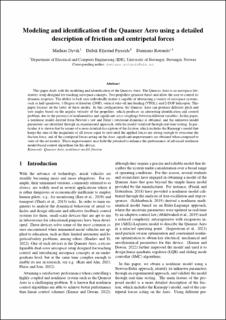| dc.contributor.author | Dyvik, Mathias | |
| dc.contributor.author | Fjereide, Didrik Efjestad | |
| dc.contributor.author | Rotondo, Damiano | |
| dc.date.accessioned | 2024-04-17T11:35:23Z | |
| dc.date.available | 2024-04-17T11:35:23Z | |
| dc.date.created | 2023-12-07T10:24:21Z | |
| dc.date.issued | 2023 | |
| dc.identifier.citation | Dyvik, M., Fjereide, D. E., & Rotondo, D. (2023). Modeling and identification of the Quanser Aero using a detailed description of friction and centripetal forces. Scandinavian Simulation Society, 246-253. | en_US |
| dc.identifier.isbn | 978-91-8075-348-7 | |
| dc.identifier.uri | https://hdl.handle.net/11250/3127018 | |
| dc.description.abstract | This paper deals with the modeling and identification of the Quanser Aero. The Quanser Aero is an aerospace laboratory setup designed for teaching aerospace concepts. Two propellers generate thrust and allow the user to control its dynamic response. The ability to lock axes individually makes it capable of abstracting a variety of aerospace systems, such as half-quadrotor, 1-Degree of freedom (DOF), vertical take-off and landing (VTOL), and 2-DOF helicopter. This paper focuses on the latter of these modes. In this configuration, the Quanser Aero can produce different pitch and yaw angles based on the angular velocity of the propellers, which produces an interesting identification and control problem, due to the presence of nonlinearities and significant cross-couplings between different variables. In this paper, a nonlinear model derived from Newton’s law and Euler’s rotational dynamics is obtained, and the unknown model parameters are identified through an experimental approach, with the model validated through real-time testing. In particular, it is shown that by means of a more detailed description of the friction, which includes the Karnopp’s model that keeps the sum of the magnitude of all forces equal to zero until the applied forces are strong enough to overcome the friction force, and of the centripetal forces acting on the Aero, significant improvements are obtained when compared to state-of-the-art models. These improvements may hold the potential to enhance the performance of advanced nonlinear model-based control algorithms for this device. | en_US |
| dc.language.iso | eng | en_US |
| dc.publisher | Linköping Universitet | en_US |
| dc.relation.ispartof | Proceedings of the 64th International Conference of Scandinavian Simulation Society | |
| dc.rights | Navngivelse 4.0 Internasjonal | * |
| dc.rights.uri | http://creativecommons.org/licenses/by/4.0/deed.no | * |
| dc.title | Modeling and identification of the Quanser Aero using a detailed description of friction and centripetal forces | en_US |
| dc.type | Chapter | en_US |
| dc.description.version | publishedVersion | en_US |
| dc.rights.holder | The authors | en_US |
| dc.subject.nsi | VDP::Teknologi: 500 | en_US |
| dc.identifier.doi | 10.3384/ecp200032 | |
| dc.identifier.cristin | 2210168 | |
| cristin.ispublished | true | |
| cristin.fulltext | original | |
| cristin.qualitycode | 1 | |

